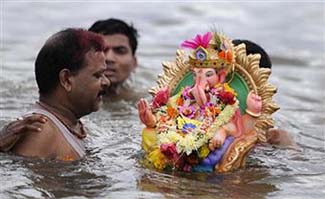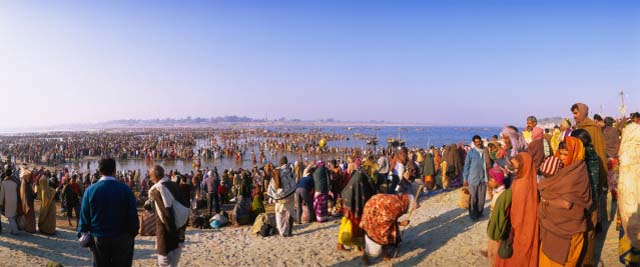Jan 01, 2026
Jan 01, 2026
During the festivals Ganesh, the Elephant God, and Goddess Durga with her progeny are worshipped, respectively. Their clay idols lovingly made with piety and passion, finished with plaster of Paris, coated with toxic enamel paints, embellished by faux ornaments and decked up in colorful synthetic clothes are installed for worship in regular or temporary temples. At the end of the ten days’ festivities these are subjected to ritualized ceremonial immersions in the nearest water bodies. This has been happening in all parts of the country where these festivals are observed with such vigor. And, the fate virtually of all the rivers and other water bodies in such parts is almost the same as that of the Yamuna. The Hindu community is, strangely, unable to appreciate the threats that it is posing to the country at large with its progressively magnifying religiosity. It seems to be killing the very environment that sustains the larger community. Whether it is land, water or air, the piety that is flaunted all over the country is polluting them all, though the Hindu religious tradition has always been worshipful of nature. Take the periodical Kumbha Melas, for instance, when pilgrims in millions take bath every day either in the Ganga at Hardwar or in Kshipra (now on the brink of extinction) at Ujjain or near the source of Godavari at Nashik or at Allahabad where the Ganga, Yamuna and the mythical Saraswati meet. Extended pilgrimages of massive proportions which demand detailed planning and comprehensive logistics, they force the governments of respective states to step into the operations that essentially are religious. What happens to the rivers, howsoever holy they are considered to be, and their ecosystems have not so far been matters of concern for those who are behind the pilgrimages and the ritualized holy baths as also those who facilitate them. The news that came out of Delhi recently was depressing. The water supply in the metropolis was disrupted as the supply lines were clogged. North, West, North-West and parts of South Delhi suffered severe shortages because of the pollution in the Hyderpur Canal which supplies water to the eponymous treatment plant. “The presence of paints, particulate matter, chunks of plastic and flowers from the idol immersions that were carried out have left our pumps choked”, said the Delhi Jal Board (Water Board). Despite there being eight water pumps water needed for treatment could not be lifted. The inevitable shortages occurred as the required amount could not be given the necessary treatment. And, the pumps got clogged because of the thousands of idols that were immersed in River Yamuna after the recent festivities. This is a new sociological phenomenon which is becoming increasingly evident every year in the upcountry after Ganesh Chaturthi and Navaratri festivals.
The news that came out of Delhi recently was depressing. The water supply in the metropolis was disrupted as the supply lines were clogged. North, West, North-West and parts of South Delhi suffered severe shortages because of the pollution in the Hyderpur Canal which supplies water to the eponymous treatment plant. “The presence of paints, particulate matter, chunks of plastic and flowers from the idol immersions that were carried out have left our pumps choked”, said the Delhi Jal Board (Water Board). Despite there being eight water pumps water needed for treatment could not be lifted. The inevitable shortages occurred as the required amount could not be given the necessary treatment. And, the pumps got clogged because of the thousands of idols that were immersed in River Yamuna after the recent festivities. This is a new sociological phenomenon which is becoming increasingly evident every year in the upcountry after Ganesh Chaturthi and Navaratri festivals.
Every year the numbers of idols installed in the urban and rural areas, particularly in the upcountry, have been on the rise. The ardor and devotion of the people disrupt normal life, upset the working schedule, cause traffic bottle-necks and (later) also pollute the very water that sustains the community. A couple of decades back the festivities used to be on a much lower scale and were not so disruptive or polluting. Lately, however, with a strong revival of religious traditions and an unprecedented surge in religious fervor, things are increasingly getting out of hand.
The way we have been going for some years now, the kind of mishap that happened in Delhi had to happen sooner or later. Clearly, the festivals have now started hurting the community. Whether it is the Hooghly River in West Bengal, the Arabian Sea near Mumbai or other inland rivers or water bodies, all have had the privilege of experiencing the unkindly, even malign after-effects of these festivities. Although, post-immersions, the idols are unceremoniously stripped of all valuables, yet what remains of them adds to the pollution of the waters that are already polluted with urban and industrial effluents. The Delhi Jal Board has only complained about the disruption of the supplies that it is supposed to make. That the River flowing through the Capital was being polluted is, seemingly, not any of its concerns.
Kumbh Mela
Likewise, the annual pilgrimage to the Amarnath cave in the Himalayas has been the cause of damage to the delicate Himalayan ecology. Earlier, a pilgrimage of roughly a week with participation of a few thousands, it has now assumed enormous proportions. It now runs for around two month and is joined, by the last count, by around 500,000 pilgrims. While the affluent few take a helicopter ride to the mouth of the 14000 ft. high Holy Cave for a quickie darshan (obeisance), most are ferried by countless diesel-run buses to Srinagar/Pahalgam to eventually trek to the cave. Things are not much different with the annual trudge of millions to the Sabarimala temple situated in the midst of densely forested hills in Kerala. The pilgrimage, for that matter any pilgrimage, has become an industry with hoteliers and tour operators feeding them with their inviting offers. The hyped-up religious festivals, on the other hand, have become occasions for marketing of all kinds of merchandise – from cars, diamond jewellery to garments – and even holidays. The environment, however, is always a casualty.
There could be any number of reasons for this gush of religiosity. It could be because of a more pro-active role played by organizations connected with the Hindu religion; it could also be because of a reaction against frequent Islamic terrorist attacks in the heartland of the country. Even the political power captured by Bharatiya Janata Party, branded by the West as the “Hindu Nationalist Party”, in several states, coupled with the post-liberalization rise in the levels of disposable incomes among the Hindu middle classes may have been factors in fuelling the heightened religious zeal. The electronic media, particularly, the TV with its outreach deep into the urban slums and rural homes telecasting gold foil-wrapped Hindu traditions, too, may have given a fillip to the rising tempo.
Whatever may be the reason(s), the whole thing, viewed objectively, appears to be sheer madness. Self-regulation and self-restraint being conspicuous by their absence, every passing year a new vigor, seemingly, is injected into the festivities. Religion and its practices being matters of very sensitive nature, no government would come out and cry a halt. Besides, there is that ‘small’ matter of votes. No political party would ever dream of alienating such a large community and losing such a sizable chunk of votes. Hindu religiosity, thus, would seem to be spiraling out of control with consequences that may, sooner than later, prove to be catastrophic for its pious and the devout.
Nonetheless, one can see a ray of hope. For the first time ever, Jairam Ramesh, Minister for Environment and Forests, has put a cap on the number of tourists travelling to Himachal Pradesh. Though inordinately late, it is a very wise step and needs replication elsewhere. World over natural assets are subjected to sensitive treatment, limiting the intrusions by humans in order to ensure their sustainability. The cap that the minister has imposed is surely based on a well-researched carrying capacity of the region. Similar caps need to be imposed for other natural assets, too, which happen to be tourism hotspots, as also those which, post-festivities, get the brunt of the idols. Such measures will be unexceptionable as they would be aimed at protecting the natural riches of the country and their vital ecosystems. If, in the process, the minister has to interfere with the peoples’ religious practices, so be it. After all, that will be for the larger good. What, however, would be needed are courage and the conviction to do the right by the country!
11-Oct-2009
More by : Proloy Bagchi